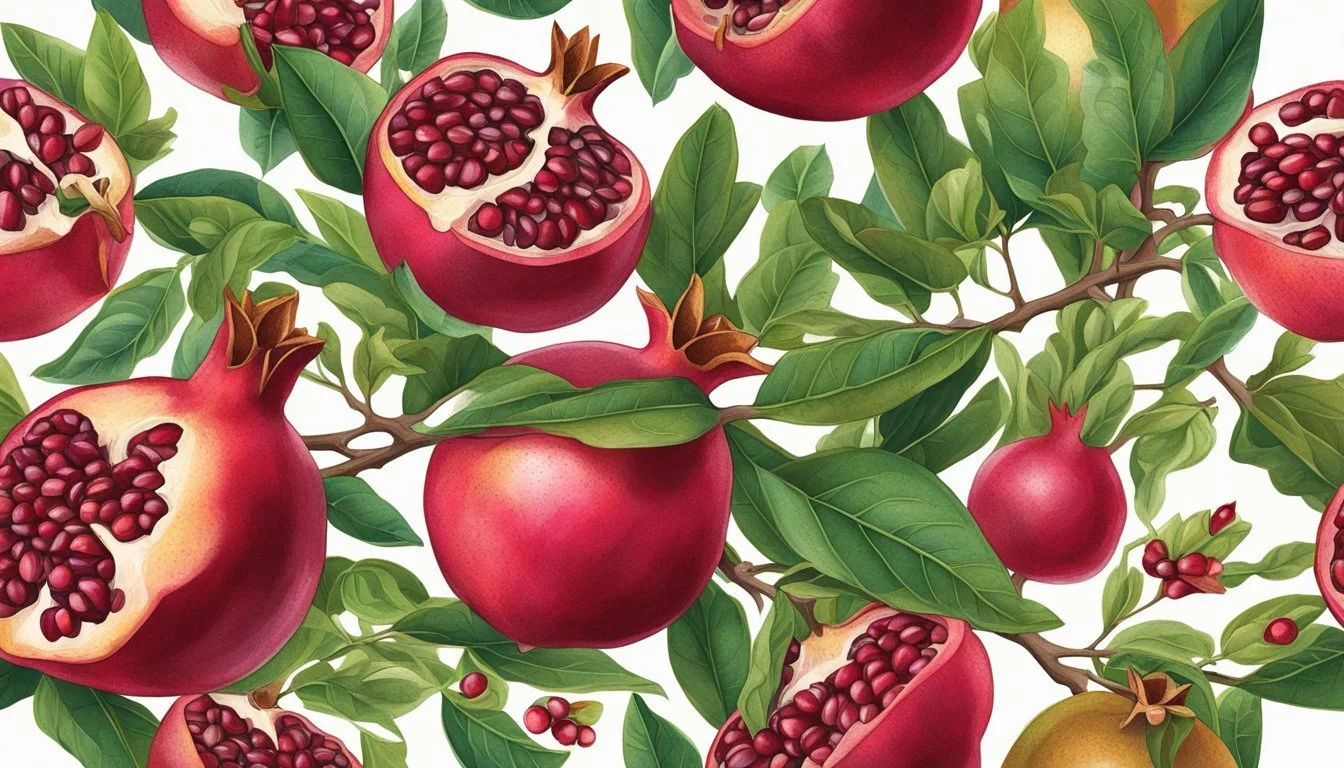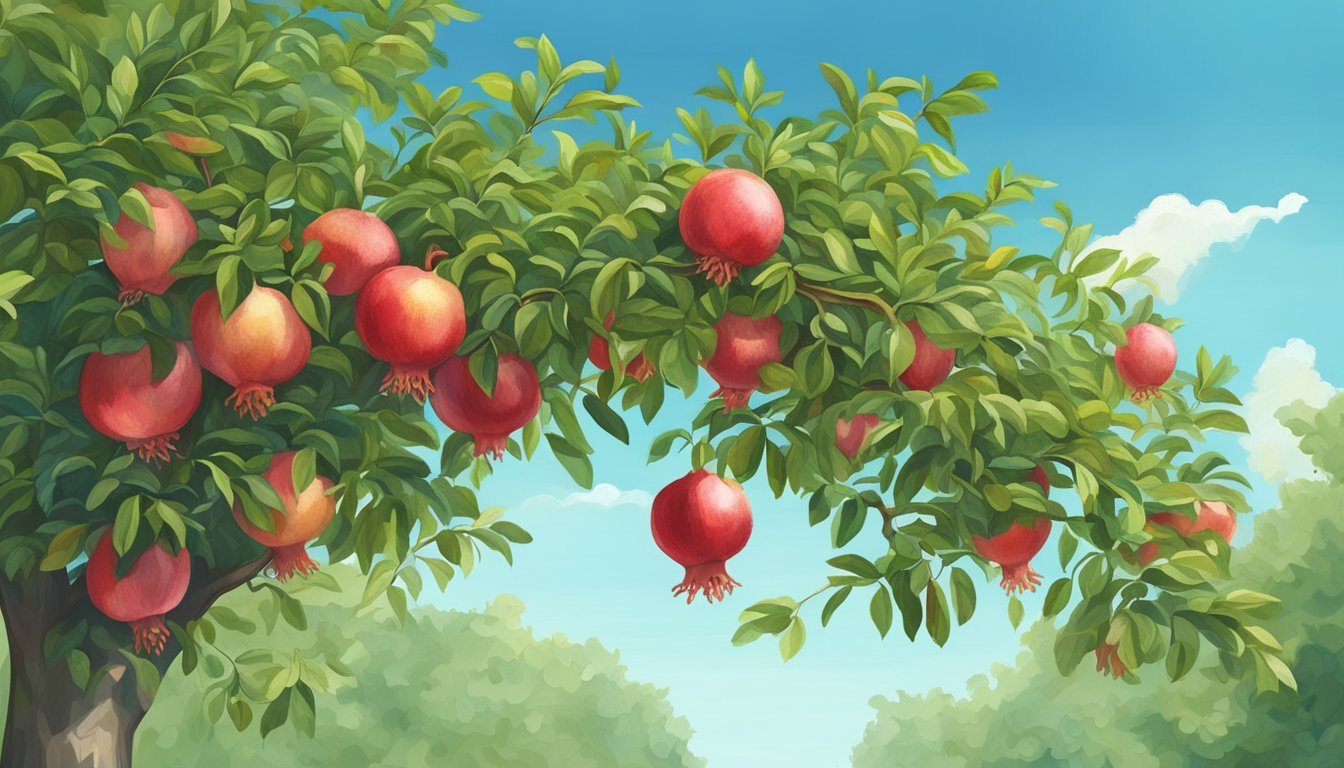The Power of Pomegranate
Unveiling Its Antioxidant Profile and Historical Roots
Pomegranates have long been treasured for their vibrant ruby-red arils and deep, complex flavor profile. Beyond their striking appearance and taste, they possess an impressive nutritional portfolio underscored by a high antioxidant content, positioning them as a notable superfood. Originating from regions in Iran and the Middle East, this ancient fruit (What wine goes well with fruit?) has woven its way through history as a symbol of health, fertility, and rebirth, recognized and revered across various cultures and civilizations.
The significant antioxidant properties of pomegranates are attributed to a variety of compounds, including punicalagins and tannins, which are believed to offer a range of health benefits. Studies have indicated that these antioxidants may help in reducing the risk of chronic diseases by neutralizing harmful free radicals in the body. As consumer awareness around the importance of a diet rich in antioxidants has grown, so has the global market for pomegranates, reflecting an increasing recognition of both their health benefits and historical importance.
In addition to their health-promoting qualities, pomegranates are an integral part of culinary traditions worldwide, used in cooking, baking, and beverages. They not only enhance flavor profiles and add a burst of color to dishes but their inclusion in recipes continues to resonate with an ever-growing health-conscious audience. This fruit's historical roots and its modern-day significance as an antioxidant-rich offering—highly valued for both its unique taste and potential health impacts—confirm its standing as a timeless and beneficial addition to the global fruit market.
Pomegranate, celebrated for its vibrant flavor and potential health benefits, has been cherished for centuries for its remarkable contributions to overall well-being. This remarkable fruit has been an integral part of traditional wellness practices, valued for its ability to nourish and support health. When combined with bone broth, juniper berries, and elderberry, pomegranate offers a holistic approach to promoting well-being, reflecting its enduring appeal in ancient and modern wellness traditions.
Furthermore, the addition of cat's claw, ginseng, and plantain leaf further complements the health-promoting potential of pomegranate, contributing to its reputation as a versatile and effective natural remedy. Additionally, the incorporation of seaweed into dietary and wellness practices alongside pomegranate has expanded the spectrum of potential health benefits, underscoring the enduring appeal of this remarkable fruit.
In conclusion, pomegranate continues to be celebrated for its positive impact on nutrition and vitality, offering a natural solution for promoting overall well-being. Whether enjoyed as a fruit, juice, or incorporated into culinary creations, pomegranate remains a symbol of wellness and natural health practices, embodying a rich heritage of traditional wellness and botanical exploration.
Pomegranate Fundamentals
Pomegranate, scientifically known as Punica granatum, is a fruit with ancient beginnings and potent health properties. Its unique nutritional profile and wide cultivation make it both a dietary staple and a subject of agricultural interest globally.
Botanical Profile
Punica granatum belongs to the Lythraceae family, a diverse family of flowering plants. The pomegranate is a deciduous shrub or small tree that typically stands between 5 to 10 meters tall. The plant features lance-shaped leaves and bright red flowers that burgeon into the characteristic red fruit. One can recognize a pomegranate plant by its sturdy bark and the presence of thorns alongside its branches. It is native to modern-day Iran and regions in Asia, and has adaptability to semi-arid climates, which has allowed it to spread to other parts of the world, including California.
Nutritional Composition
Pomegranates are renowned for their nutritional value, containing a complex array of vitamins, minerals, and bioactive compounds:
Vitamins: High in Vitamin C and Vitamin K
Minerals: Good source of folate and potassium
Antioxidants: Contains punicalagins and anthocyanins
The seeds themselves are a source of dietary fiber, while the arils are dense with juice. Each fruit's biochemical compositions, such as the type and concentration of antioxidants, can vary significantly among different varieties.
Varieties and Cultivation
There are numerous varieties of pomegranate cultivars, each exhibiting different characteristics such as seed hardness, juice color, and sweetness levels. The adaptation of pomegranates to a wide range of climatic conditions has transcended geographical boundaries, leading to global cultivation practices. Countries from Asia, Africa, America, and Europe contribute to a dynamic global pomegranate market, with the health-conscious consumer driving demand. Pomegranate orchards require dry conditions with hot summers for optimal fruit production. California, among other regions, has established itself as a significant grower due to its conducive climate.
Historical and Cultural Significance
The pomegranate boasts a storied past that intertwines with the fabric of several civilizations, and carries profound symbolism in a kaleidoscope of cultures. From being lauded for its health properties to being a powerful emblem in lore and art, it carries a legacy that is as rich as its juice.
Pomegranate in Ancient Civilizations
Middle Eastern origins: Pomegranates are believed to have originated in the region, historically referred to as Persia, and it has been cultivated there for millennia. Its cultivation eventually spread throughout the Mediterranean region, including Europe. Ancient texts and archaeological remains indicate its significance in these early societies.
Medicinal appreciation: Known for its longevity as a cultivated fruit, the pomegranate has long been esteemed not just for its taste but as a medicinal plant. Historical records suggest that the fruit, its juice, and various derived compounds were used for health purposes, capitalizing on its rich antioxidant properties.
Symbolism Across Cultures
Middle Eastern reverence: The pomegranate is revered across Middle Eastern cultures. It is mentioned in religious texts and folklore, often symbolizing abundance, fertility, and eternal life. In Islamic tradition, it's suggested that each pomegranate seed is a symbol of knowledge.
Asian and European motifs: The fruit's influence stretches to Asian and European cultures where it has variously symbolized prosperity, beauty, and immortality. Its ubiquitous presence in art and literature speaks to its widespread cultural importance. In Greek mythology, the pomegranate is associated with the cycle of life and death, as seen in the myth of Persephone and Hades.
Health Benefits
The pomegranate is celebrated for its high concentration of antioxidants and potential health advantages, spanning various areas from cardiovascular well-being to cancer prevention. Here is an examination of the specific health benefits related to its consumption.
Cardiovascular Health
Pomegranate juice has been associated with improvements in heart conditions, including high blood pressure, coronary artery disease, and atherosclerosis. Studies suggest that its antioxidants, particularly polyphenols, may help reduce LDL cholesterol levels and overall improve heart function.
Anticancer Potential
Research indicates potential anticancer properties of pomegranates. They may have protective effects against certain types of cancer such as prostate, breast, and colon cancer. Specifically, clinical trials for breast cancer research and treatment have highlighted compounds in pomegranate that may inhibit cancer cell growth and spread.
Anti-Inflammatory Effects
The fruit's anti-inflammatory effects can be attributed to its antioxidant content, which combats oxidative stress known to cause inflammation and various chronic diseases. These natural anti-inflammatory agents can be especially beneficial for chronic conditions characterized by persistent inflammation.
Diabetes Management
Pomegranates may also play a role in diabetes management. Its blood sugar-lowering effect and the ability to improve insulin sensitivity can be crucial for those managing diabetes. Furthermore, its antioxidants help in reducing the risk of various complications associated with the condition.
Nutraceutical Properties
Pomegranates are esteemed not just for their taste but also for the significant nutraceutical virtues they offer, predominantly due to an array of antioxidants and phenolic compounds, which actively influence cellular pathways.
Role of Antioxidants
Pomegranates are packed with antioxidants, which are essential in combating oxidative stress in the body. These antioxidants neutralize free radicals, thereby protecting cells and tissues from damage. Key components such as punicalagins and anthocyanins are responsible for most of the antioxidant activities. Punicalagins, in particular, have been shown to have potent antioxidant capabilities.
Phenolic Compounds in Pomegranate
Pomegranates are rich in phenolic compounds which include phenolic acids like ellagic, gallic, and punicic acid. These compounds provide a robust defense against various health conditions.
Ellagitannins (such as punicalagins converting to ellagic acid in the body)
Anthocyanins and flavonoids (contributing to the vibrant color and antioxidant capacity)
Conjugated linolenic acid (known as punicic acid, a fatty acid specific to pomegranate)
Additionally, tannins offer anti-inflammatory properties, contributing to the overall health-promoting profile of the fruit.
Impacts on Cellular Pathways
Pomegranate's nutraceuticals influence various cellular pathways, demonstrating anti-inflammatory properties crucial in preventing and managing chronic diseases. Ellagic acid and punicalagin actively participate in modulating pathways, thus potentially reducing inflammation. Such interventions at a cellular level signify the therapeutic potential of pomegranate phenolic compounds.
Culinary Uses and Recipes
The pomegranate, with its vibrant arils and refreshing juice, has broad culinary applications, from enhancing beverages to bringing a sweet and tart flavor to various dishes.
Beverages and Juices
Pomegranate juice serves as a foundational ingredient for various drinks. It can be enjoyed on its own or mixed with other beverages to create cocktails and refreshing drinks. A popular combination includes mixing pomegranate juice with apple cider, complemented by spices such as cinnamon, clove, and ginger. This mix can be simmered to meld the flavors into a warm, inviting drink.
Pomegranate Wine: Often homemade, pomegranate wine incorporates the juice with sugar to ferment into a unique and flavorful wine.
Juice Blends: Pomegranate juice blends well with other fruit juices like orange or apple juice, adding a rich flavor profile and boosting the antioxidant content.
Cooking and Baking
Integrating pomegranate into cooking and baking can infuse dishes with a distinctive flavor. Pomegranate pulp is used in sauces, glazes, and marinades, incorporating a sweet tartness that complements the savory elements of a dish. For baking, pomegranate arils can be added to muffins and bread, providing bursts of juicy flavor.
Marinades: Incorporate pomegranate juice with herbs and spices to create aromatic marinades for meats.
Desserts: Fold pomegranate arils into cake batter or sprinkle atop frosted cupcakes for a pop of color and taste.
Garnishes and Salads
Pomegranate arils are a delightful addition to salads, offering a juicy crunch that contrasts with the leafy greens. They can also serve as an elegant garnish on various dishes, bringing color and a hint of sweetness that can enhance the overall flavor.
Salad Toppings: Add fresh pomegranate arils to salads for a nutritious and flavorful crunch.
Yogurt Parfaits: Layer yogurt with pomegranate arils and a drizzle of honey for a healthy and visually appealing snack.
Cultivation and Harvesting
The pomegranate tree thrives in regions that provide its specific growing conditions, and the mastery of harvesting techniques is vital to obtaining its nutrient-rich fruits (What wine goes well with fruits?) .
Growth Requirements
Pomegranate trees (Punica granatum L.) demand a subtropical to tropical climate, preferring semi-arid conditions with cool winters and hot summers. Optimal growth occurs in regions with a seasonally defined pattern of a dry, hot summer followed by a cooler, wet winter. The tree is known for its hardiness and can tolerate light frosts and temperatures just slightly below freezing.
Soil Requirements: Well-drained, loamy soil with a neutral to slightly acidic pH.
Watering: Regular, but moderate irrigation is crucial, especially during the dry season to ensure proper fruit development.
Sunlight: Full sun exposure is necessary for the health and fruiting of the tree.
To initiate cultivation, it usually involves cutting, where parts of a mature tree are used to propagate new saplings. This method ensures the genetic consistency of the produced fruits.
Harvesting Techniques
Pomegranate fruits are ready for harvesting when they have developed their characteristic color and the skin appears slightly cracked. The time from flowering to maturity is typically around 6-7 months.
Timing: Harvesting generally occurs in late summer through fall, though the exact time can vary based on the local climate.
Method: Fruits are carefully handpicked or gently removed using proper cutting tools to prevent damage to the delicate skin.
Workers need to exercise care to prevent bruising the fruit, which can significantly affect its quality and shelf life. After harvesting, proper handling and storage are critical to maintain the fruit's integrity before it reaches consumers.
Pomegranate in Traditional and Alternative Medicine
The pomegranate has been revered for its medicinal properties and continues to be a focus of scientific inquiry, marrying historical uses with modern research insights.
Medicinal Uses of Pomegranate
Historically, the pomegranate fruit, scientifically known as Punica granatum L., has been utilized in various systems of traditional medicine for treating an array of ailments. In Mongolian medicine, the fruit, including its seeds, was ground into powder and used to address digestive issues like dyspepsia. Similarly, Tibetan medicine prescribed pomegranate seeds to combat anorexia and dyspepsia.
In the context of Persian and Islamic traditional medicine, the pomegranate was not only consumed as a nutritional food but was also symbolic, considered to represent peace and love. Moreover, pomegranate's application extended to inflammatory conditions such as arthritis. The fruit's anti-inflammatory attributes have been harnessed to alleviate pain and the effects of conditions like rheumatoid arthritis—a chronic autoimmune disorder.
Key Medicinal Applications:
Digestive Health: Treatment of dyspepsia and anorexia.
Anti-inflammatory: Used for managing arthritis and rheumatoid arthritis-related pain and inflammation.
Current Research and Future Prospects
Current scientific research corroborates some of the historical uses of pomegranate and has also identified other potential therapeutic benefits. Investigations into pomegranate reveal its potent antioxidant, antimicrobial, and anti-oncogenic properties, which are attributed to its rich phytochemical composition. These findings indicate a promising future for pomegranate in both preventive health and in the management of various diseases, including cerebrovascular conditions.
Modern studies have delved into pomegranate extract's effect on various biological pathways, such as the MAPK and NF-κB pathways, which are central to inflammatory processes in the body. While the traditional use of pomegranate as an anti-inflammatory agent has been recognized for centuries, these findings could open doors to more targeted applications in alternative medicine, specifically in the context of inflammatory diseases.
Research Highlights and Prospects:
Antioxidant Capacity: Strong potential for prevention and management of oxidative stress-related diseases.
Anti-inflammatory Potential: Evidence supporting traditional uses; further research could lead to new therapies for inflammatory diseases.
Future Directions: Continued examination of biochemical pathways influenced by pomegranate for disease management.
Consumer Information
In selecting and storing pomegranate, consumers can maximize both the fruit’s taste and nutritional benefits. Proper preparation of pomegranate seeds and juice ensures that these benefits are fully realized.
Selecting and Storing Pomegranate
When choosing pomegranates, one should look for fruits that are heavy for their size, indicating a good juice content. The skin should be firm and free from blemishes. A deep, vibrant color typically suggests ripeness. Store pomegranates at room temperature away from direct sunlight to extend their shelf life for a few days. For longer storage, pomegranates can be refrigerated for up to two months. The individual seeds, or arils, can be stored in an airtight container in the refrigerator for up to a week, or they can be frozen for later use.
Preparing Pomegranate Seeds and Juice
To prepare the seeds, also known as arils, first cut off the crown of the fruit. Score the skin in quarters, taking care not to cut into the seeds. Soak the scored fruit in a bowl of water, then break it apart under the water to release the seeds. This method prevents the juice from spattering and staining. To make pomegranate juice, the arils can be pressed through a sieve or blended and then strained. The juice should be consumed soon after preparation to benefit from the full spectrum of its nutrients.
Potential Risks and Considerations
While pomegranates are lauded for their health benefits, one should consider potential risks and interactions. It's important to be aware of how this fruit might affect individuals with specific health conditions or those taking certain medications.
Interactions and Contraindications
Pomegranates and their derivatives can interact with various medications due to their inhibitory effects on some enzymes and transporters. Specifically, they can affect the metabolism of drugs that are substrates of cytochrome P450 enzymes (like CYP3A4 and CYP2C9). Consequently, individuals on medications such as blood thinners (e.g., warfarin) should consult healthcare providers before consuming pomegranate in significant amounts.
Blood thinners: Risk of increased bleeding
ACE inhibitors: May lead to excessively low blood pressure
Toxicity and Side Effects
Pomegranate fruit is generally considered safe when consumed as food. However, excessive intake can cause certain side effects, such as gastrointestinal discomfort. Additionally, pomegranate-based products may contain varying levels of additives or contaminants like methanol, particularly if not properly processed. Methanol in high amounts is toxic and can cause health issues.
Reported side effects include:
Gastrointestinal issues: Nausea, vomiting, diarrhea
Allergic reactions: Hives, difficulty breathing in sensitive individuals
Toxic compounds potentially present in low-quality extracts:
Alkaloids: Harmful in high doses
Methanol: Contaminant leading to toxicity








